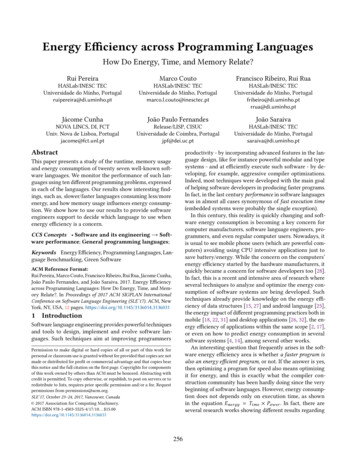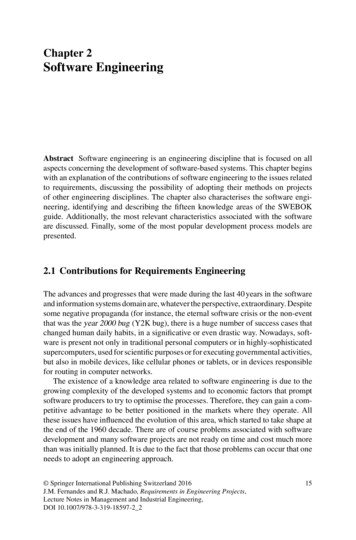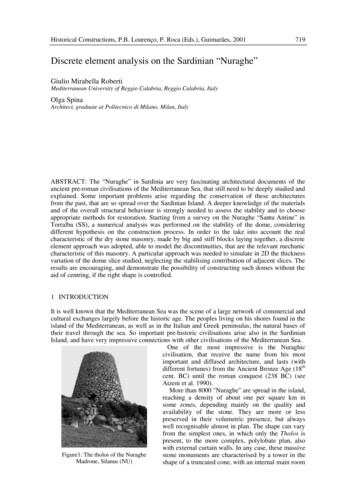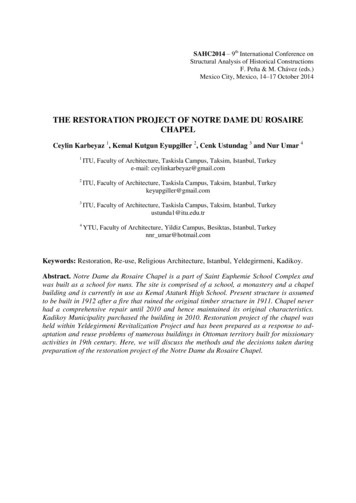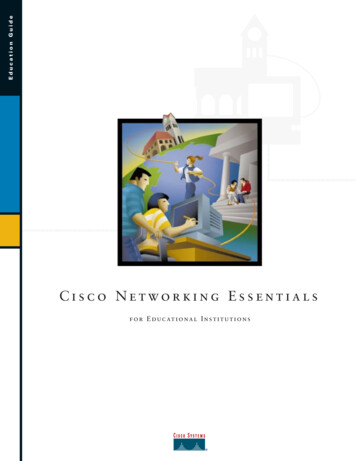
Transcription
Education GuideCisco Networking Essentialsf o r E du c at i o n a l I n s t i t u t i o n s
Cisco Systems, Inc., the worldwide leaderi n n e t wo r k i n g f o r t h e I n t e r n e t, h asprepared this guide to make networkinge as i e r f o r yo u r cam p u s or district. Ifyou’re new to networking, i t ’ s an idea lintroduction, starting with the most basic of components and helping you pinpoint thebest technologies and design for your network. If you already know your networkingABCs, look to this guide for straightforward explanations of key terms and concepts tokeep building your knowledge base.Cisco solutions are at the foundation of thousands of education networks worldwide,f ro m l e a d i n g u n i v e rs i t i e s to c a m p u s c o m p u t e r l a b s . We h av e a s t ro n g c o m m i t m e n tto making education networks powerful, practical learning resources and preparingtoday’s students to excel in the information economy. What’s more, 80 percent of therouters that make up the Internet are from Cisco. Virtually all Internet traffic flowsthrough Cisco equipment. So when you install Cisco, you’re choosing the networkingequipment proven suitable for the world’s largest and fastest-growing networks.Fo r deta ils on C i sc o sol ut i o ns f o r yo u r n e t wo rks o r e du cat i o n i n i tiativ es,call 800 778 3632, ext. 6030, or visit our Web site at www.cisco.com/edu.
Table of ContentsWhat This Guide Can Do for You1The Building Blocks: Basic Components of Networks2Clients and Servers2Wiring and Cable3Network Interface Cards3Hubs4Margin Note: Network Management4Margin Note: Modems4Switches5Routers5Margin Note: Uninterruptible Power Supplies6Margin Note: Bridges6Networking Technologies Overview7Local-Area Networks: Ethernet and Fast Ethernet7Remote Access and Wide-Area Networks9Margin Note: Token Ring9Margin Note: High-Speed LAN Technologies9Education Networking Examples14A Local-Area Network at a Campus14As the Campus Network Grows15A Wide-Area Network for a Small District16A Community College WAN16Making the Right Connection: Network How-Tos17How to Connect to the Internet17How to Choose an Internet Service Provider19How to Create Your Own Web Site20Margin Note: Instant Web Content for Education20Margin Note: Security20Basic Network Design: Considerations21A Problem Solvers’ Guide to Relieving Congestion21How to Spot Network Congestion21Good Network Design: The 80-20 Rule23Giving Your Network a Performance Boost24Dedicated Bandwidth to Workgroups and Servers25Analog Lines10Margin Note: Types of Ethernet Traffic25Margin Note: Analog vs. Digital10Making the Most of YourISDN11Existing Equipment as Your Network Evolves26Margin Note: Modems vs. Routers11Leased Lines12Networking Basics Checklist27Margin Note: The Universal Service Fund, or E-Rate12For Building a Small LAN27Margin Note: Fund-Raising for Networking Projects12For Connecting Buildings on a Campus27Margin Note: Remote Access Servers12For Connecting to Another Campus or District28Which Service Is Right for You?13Margin Note: Training and Support28Glossary29Who Is Cisco Systems?31
What This Guide Can Do for YouMost people wouldn’t use the terms “networking” and“basic”in the same sentence. However, while the underlyingprinciples of networking are somewhat complex, buildinga network can be very simple given the right tools and a basicunderstanding of how they work together.With networks, starting small and planning to growmakes perfect sense. Even a modest network can paylarge dividends by saving time; improving communicationbetween faculty, students, and parents; increasing productivity; and opening new paths to learning resources locatedanywhere in the world. In this respect, networks are likecars. You don’t have to know the details about how the engineworks to be able to get where you need to go.As a result, this guide does not attempt to make youa networking expert. Instead, it has been carefully designedto help you: Understand the primary building blocks of networks andthe role each one plays. Understand the most popular networking technologiesor methods of moving your data from place to place. Determine which approach to networking and whichtechnologies are best for your campus or district campus.Throughout “Cisco Networking Essentials for EducationalInstitutions,” you will find Margin Notes—helpful sidelightson subjects related to the main concepts in each section.Terms highlighted in color may be found in the glossaryin back.
The Building Blocks: Basic Components of NetworksThere are as many definitions for the term “network” asEvery network includes:there are networks. However, most people would agree At least two computersthat networks are collections of two or more connected A network interface on each computer (the device thatcomputers. When their computers are joined in a network,lets the computer talk to the network—usually calledpeople can share files and peripherals such as modems,a network interface card [NIC] or adapter) A connection medium—usually a wire or cable, butprinters, tape backup drives, and CD-ROM drives. Whenwireless communication between networked computersnetworks at multiple locations are connected using servicesand peripherals is also possibleavailable from phone companies, people can send e-mail,share links to the global Internet, or conduct videoconfer- Network operating system software—such as MicrosoftWindows 95 or Windows NT, Novell NetWare, AppleShare,ences in real time with other remote users on the network.or Artisoft LANtasticMost networks—even those with just two computers—alsohave a hub or a switch to act as a connection point betweenthe computers.Basic Networking oftwarePCPCCableNIC CardMost networks consist of at least two computers, network interface cards,cabling, network operating system software, and a hub.CableNIC CardHubClients and ServersOften, as a network grows and more computers areNote that you don’t need to have a dedicated server inadded, one computer will act as a server—a central storageyour network. With only a few computers connected,point for files or application programs shared on the net-networking can be “peer to peer.” Users can exchange fileswork. Servers also provide connections to shared peripheralsand e-mail, copy files onto each others’ hard drives andsuch as printers. Setting up one computer as a servereven use printers or modems connected to just one computer.prevents you from having to outfit every networked computerAs more users are added to the network, however, havingwith extensive storage capability and duplicate costlya dedicated server provides a central point for managementperipherals. The computers that connect to the server areduties such as file backup and program upgrades.called clients.
Wiring and CableNetwork interface cardsNetwork interface cards(NICs), or adapters, areusually installed insidea computer’s case. Withportable and notebookcomputers, the NIC isTwisted PairCoaxialFiber-OpticNetwork Interface Cardusually in the credit cardsized PC card (PCMCIA) format, which is installed in aNetworks use three primary types of wiring (also referredslot. Again, when selecting NICs, plan ahead. Ethernetto as “media”):NICs support only Ethernet connections, while 10/100Twisted-pair—the industry standard in new installations.NICs cost about the same and can work with eitherThis wire comes in several “standards.” Unshielded twistedEthernet or higher-performance Fast Ethernet connec-pair (UTP) Category 3 wire (also called 10BaseT) istions. In addition, you need to ensure that your NICs willoften used for your phone lines, and UTP Category 5 (alsosupport the type of cabling you will use—twisted-paircalled 10Base2) wire are the current networking standards.(also called 10BaseT), coaxial (also called 10Base2), orCoaxial—resembles round cable TV wiring.Fiber-optic—usually reserved for connections between“backbone” devices in larger networks, though in somevery demanding environments, highly fault resistant fiberoptic cable is used to connect desktop workstations to thenetwork and to link adjacent buildings. Fiber-optic cableis the most reliable wiring but also the most expensive.Care should be taken in selecting the cabling for yourclassrooms and buildings. You want to be sure the wiresrunning through ceilings and between walls can handlenot only your present needs, but any upgrades you foreseein the next several years. For instance, Ethernet can useUTP Category 3 wiring. However, Fast Ethernet requires atleast the higher-grade UTP Category 5 wiring. As a result, allnew wiring installations should be Category 5. You mayalso want to explore plenum cable, which can be routedthrough many types of heating and cooling ducts in ceilings.Check with your architect or wiring contractor to ensurethis process is fire code compliant.a mixture of both.
HubsNetwork ManagementHubs, or repeaters, areNetwork management software allows you to monitor trafficsimple devices that inter-flows, configure new equipment, and troubleshoot networkconnect groups of users.problems.“Managed” hubs and switches have the ability to tellHubs forward any datapackets they receive overa network management software “console” how much dataHubone port from one work-they are handling, sound alarms when problems occur, and recordstation—including e-mail, word processing documents,traffic volumes over time to help you understand when usersspreadsheets, graphics, or print requests—to all of theirare placing the heaviest demands on the network throughout theremaining ports. All users connected to a single hub orstack of connected hubs are in the same “segment,” sharingday. While not essential for very small networks, network man-the hub’s bandwidth or data-carrying capacity. As moreagement becomes increasingly important as the network grows.users are added to a segment, they compete for a finiteWithout it, keeping traffic flowing smoothly throughout theamount of bandwidth devoted to that segment.network, adding or moving users, and troubleshooting problemscan be difficult guessing gamesExamples of Cisco hub products:Cisco Micro Hub seriesCisco FastHub seriesModemsModems are used for “dialup” communications; in other words,For example.To understand how a hub serves your campusnetwork, imagine a hotel with just one phone line availableto all guests. Let’s say one guest wants to call another. Shethey dial up a network connection when needed, and whenthe transmission is completed, the connection is disabled. Theypicks up her phone and the phone rings in all rooms. Allwork with ordinary telephone lines. When you want to sendthe other guests have to answer the phone and determinedata across telephone lines, the modem takes the informationwhether or not the call is intended for them. Then, as longfrom digital format and converts it (or modulates it) into an analogas the conversation lasts, no one else can use the line. Withsignal. The receiving modem converts the analog signal backonly a few guests, this system is marginally acceptable.However, at peak times of the day—say, when everyonereturns to their rooms at 6 p.m.—it becomes difficult tocommunicate. The phone line is always busy.into digital form (or demodulates it) to be read by your computer.This modulating and demodulating gives the modem its name.4
InternetSwitchesRoutersSwitches are smarterCompared to switchesthan hubs and offerand bridges, routersmo re ba ndw i dt h . Aare smarter still. Routersswitch forwards datause a more completepa c ke t s onl y t o th eappropriate port for theSwitchintended recipient, based on information in each packet’spacket “address” todetermine which routerRouteror workstation should receive each packet. Based onheader. To insulate the transmission from the other ports,a network roadmap called a “routing table,” routers canthe switch establishes a temporary connection betweenhelp ensure that packets are traveling the most efficient pathsthe source and destination, then terminates the connectionto their destinations. If a link between two routers goeswhen the conversation is done.down, the sending router can determine an alternate routeAs such, a switch can support multiple “conversations”and move much more traffic through the network thanto keep traffic moving.Routers also provide links between networks that speaka hub. A single eight-port Ethernet hub provides a total ofdifferent languages—or, in computer speak—networks that10 megabits per second (Mbps) of data-carrying capacityuse different “protocols.” Examples include IP (Internetshared among all users on the hub. A “full-duplex,” eight-portProtocol), the IPX (Internet Packet Exchange Protocol),Ethernet switch can support eight 10-Mbps conversationsand AppleTalk. Routers not only connect networks in aat once, for a total data-carrying capacity of 160 Mbps.single location or set of buildings, but they provide inter-“Full-duplex” refers to simultaneous two-way communications,faces—or “sockets”—for connecting to wide-area networksuch as telephone communication. With half-duplex commu-(WAN) services. These WAN services, which are offered bynications, data can move across the cable or transmissiontelecommunications companies to connect geographicallymedium in just one direction at a time.dispersed networks, are explained in more detail in thenext chapter.Examples of Cisco switch products:Cisco 1548 Micro Switch 10/100Cisco Catalyst SeriesFor example.Switches are like a phone system with privatelines in place of the hub’s “party line.” Jane Tipton at theBerkeley Hotel calls Bill Johnson in another room, and theoperator or phone switch connects the two of them on adedicated line. This allows more conversations at a time,so more guests can communicate.
Examples of Cisco router products:Uninterruptible Power SuppliesCisco 700 seriesUninterruptible power supplies (UPS) are not essential to networksCisco 1000 seriesCisco 1600 seriesCisco 2500 seriesbut are highly recommended. They use constantly rechargingbatteries to prevent momentary power outages from shuttingCisco 2600 seriesdown your network servers or clients. Most of them alsoCisco 3600 seriesprovide protection against potentially damaging voltage spikesCisco 4500 seriesand surges.For example.To understand routing, imagine theBerkeley Hotel and all the other fellow hotels in its chainBridgeshave trained their operators to be more efficient. WhenAs the network becomes crowded with users or traffic, bridgesguest Jane Tipton at the Berkeley Hotel calls guest Ritacan be used to break them into multiple segments. SwitchesBrown at the Ashton Hotel, the operator at the Berkeleyare basically multiple bridges in a single device. Bridges helpknows the best way to patch that call through. He sendsit to the Pembrook operator, who passes it to thereduce congestion by keeping traffic from traveling onto theAshton. If there’s ever a problem with the switchboard atnetwork “backbone” (the spine that connects various segmentsthe Pembrook, the operator at the Berkeley can use anor “subnetworks”). If a user sends a message to someone inalternate route to get the call through—for example, byhis own segment, it stays within the local segment. Only thoserouting it to another hotel’s switchboard, which inpackets intended for users on other segments are passed ontoturns sends the call to the Ashton.the backbone. In today’s networks, switches are used wherethe simplicity and relative low cost of bridges are desired.6
Networking Technologies OverviewIf multiple stations sense an opening and start sendingLocal-Area Networks:Ethernet and Fast Ethernetat the same time, a “collision” occurs. Then, each stationEthernet has been around since the late 1970s and remainswaits a random amount of time and tries to send its packetthe leading network technology for local-area networksagain. After 16 consecutive failed attempts, the original(LANs). (A LAN is a network contained in a building orapplication that sent the packet has to start again. As moreon a single campus.) Ethernet is based on carrier sensepeople try to use the network, the number of collisions,multiple access with collision detection (CSMA/CD). (Seeerrors, and subsequent retransmits grows quickly, causingthe margin note on Token Ring for another basic stylea snowball effect.of network communication.)Simply put, an Ethernet workstation can send dataCollisions are normal occurrences, but too manycan start to cause the network to slow down. When morepackets only when no other packets are traveling on thethan 50 percent of the network’s total bandwidth is used,network, that is, when the network is “quiet.” Otherwise,collision rates begin to cause congestion. Files take longerit waits to transmit, just as a person might wait for anotherto print, applications take longer to open, and users areto speak during conversation.forced to wait. At 60 percent or higher bandwidth usage,the network can slow dramatically or even grind to a halt.Shared EthernetEtherSwitched Ethernet
Shared Fast EthernetAs noted in the previous section, Ethernet’s bandwidthor data-carrying capacity (also called throughput) is 10 Mbps.Fast Ethernet (or 100BaseT) works the same way—throughcollision detection—but it provides 10 times the bandwidth,or 100 Mbps.Shared Ethernet is like a single-lane highway witha 10-Mbps speed limit (see diagrams below). Shared FastEthernet is like a much wider highway with a 100-Mbpsspeed limit; there is more room for cars, and they cantravel at higher speeds. What would Switched Ethernetlook like? A multilane highway with a speed limit of 10Mbps in each lane. Switched Fast Ethernet also would bea multilane highway, but with a speed limit of 100 Mbpsin each lane.Switched Fast Ethernetnet8
Token RingToken Ring is a “token-passing” technology and an alternative toRemote Access and Wide-AreaNetworksEthernet’s collision-detection method. A token travels throughLANs accommodate local users—people within a buildingthe network, which must be set up in a closed ring, and stops ator on a campus. WANs connect users and LANs spreadbetween various sites, whether in the same city, across theeach workstation to ask whether it has anything to send. If not,country, or around the world. “Remote access” refers tothe token continues to the next point on the network. If there isa simple connection, usually dialed up over telephone linesdata to send, the sending station converts the token frame into aas needed, between an individual user or very smalldata frame and places it into the ring. The frame continuesbranch office and a central network.around the ring, sets repeated by all stations, but the destinationYour campus gains access to the Internet throughsome type of remote connection. A single user can use astation also copies the frame into memory. When the framemodem to dial up an Internet service provider (ISP). Multi-comes around to the sending station, it strips the data frameple users within a campus might choose to rely on a routerfrom the ring and releases a new token. Token Ring networksto connect to the ISP, who then connects the campus tooperate at either 4 or 16 Mbps, but with the low cost, ease ofuse, and easy migration to higher performance in Ethernetnetworks, Token Ring is rarely used for new network installations.the Internet.In general, LAN speeds are much greater than WANand remote access speeds. For example, a single sharedEthernet connection runs at 10 Mbps (mega means “million”).Today’s fastest analog modem runs at 56 kilobits per secondHigh-Speed LAN TechnologiesToday’s growing, fast-changing networks are like growing(Kbps) (kilo means “thousand”)—less than one percent ofthe speed of an Ethernet link. Even the more expensive,dedicated WAN services such as T1 lines don’t compare (withcommunities; the traffic they create tends to cause congestionbandwidth of 1.5 Mbps, a T1 lines has only 15 percent ofand delays. To alleviate these problems, you can install higher-the capacity of a single Ethernet link). For this reason, properspeed LAN technologies in your network that move traffic morenetwork design aims to keep most traffic local—that is,quickly and offer greater data-carrying capacity than Ethernet,Fast Ethernet, or Token Ring. Fiber Distributed Data Interface(FDDI) is another “token-passing” technology, operating at 100Mbps. But because it requires different wiring (fiber) and different hubs and switches from Ethernet, FDDI is losing ground toFast Ethernet and other high-speed technologies. AsynchronousTransfer Mode (ATM) operates at a range of speeds up to 622Mbps. It is a popular choice for the backbones of extremelydemanding or large networks, it has special features such asthe ability to carry voice and video traffic along with data, andit can be used for wide-area networks connecting geographically separated sites. Gigabit Ethernet operates at 1000 Mbpsand is fully compatible with Ethernet and Fast Ethernet wiringand applications.contained within one site—rather than allowing that trafficto move across the WAN.
Analog LinesAnalog vs. DigitalUsing analog lines to dial out to other networks or toThe difference between analog and digital signals is very impor-the Internet—or to allow remote users to dial into yourtant for data communications. The most familiar “analog”network—is a straightforward solution. Most ordinaryphone lines are analog lines. Connect a modem to yourcommunication is a phone call. Varying electrical voltage reflectscomputer and to a wall jack and you’re in business. Youthe variations in the volume and tone of the human voice. Bypay for a connection as you would pay for a phone call—contrast, digital communications use a series of 1s and 0s toby the minute, or a set rate per local call (long distancecarry information from point to point. Modems actually convertcharges are the same as for a long distance telephone call).the digital data of one computer into an analog signal for trans-At present, the fastest analog modems operate at56 Kbps for transferring data. With today’s larger file sizesmission over the phone lines. On the receiving end, anotherand graphically sophisticated World Wide Web sites on themodem converts the analog signal back into a series of 1s and 0s,Internet, you should look for modems that operate at aso the receiving computer can interpret the transmission. Today,minimum of 33.6 Kbps (also called V.34) and havephone companies can offer fully digital service between LANsV.42 (error correction) and V.42bis (data compression)capabilities for better performance.While modems offer a simple solution for dialout(leased lines such as 56 K, 384 K, and T1s are digital services), orIntegrated Services Digital Network (ISDN) which allows dialupconnections to other LANs and the Internet, they do not scaleconnections on an as-needed basis. When it comes to movingwell as your network grows. Each modem can support onlydata, digital communications are less susceptible to errors andone remote “conversation” at a time, and each device thatfaster than analog signals because they are not susceptible towants to connect with the outside world needs a modem.See the examples in the next section for ways to overcomethis limitation by installing a router for wide-area communications and your Internet link.problems such as electrical “noise” on transmission lines.10
Modems vs. RoutersISDNWhen choosing between modems and routers for remoteISDN is a service that operates at 128 Kbps and is availableaccess to a central network or the Internet, consider thefrom your phone company. Charges for ISDN connectionsfollowing pros and cons:usually resemble those for analog lines—you pay per calland/or per minute, usually depending on distance. ISDNcharges also can be flat rate if linked to a local Centrex system.ModemsTechnically, ISDN consists of two 64-Kbps channels Inexpensivethat work separately. Load-balancing or “bonding” of the Good for one user or limited remote access for a small grouptwo channels into a 128-K single channel is possible when Portable, so they can be used remotely from any location witha phone lineyou have compatible hardware on each end of a connection(for instance, between two of your campuses). What’s more,as a digital service, ISDN is not subject to the “line noise” Compatible with existing telephone linesthat slows most analog connections, and thus offers actual Connections can be made at a relatively low cost (essentiallythroughput much closer to its promised maximum rate.the same as a local or long-distance phone call)You can make ISDN connections either with an ISDNready router or with an ISDN terminal adapter (alsocalled an ISDN modem) connected to the serial port of yourRoutersrouter. Again, modems are best for single users, because Support faster WAN connections than modemseach device needs its own modem, and only one “conver- Support multiple userssation” with the outside world can happen at any one time. Many routers have a “live” connection (so you don’tYour ISDN router, modem, or terminal adapter may comewith analog ports, allowing you to connect a regularget busy signals), and you save time not having to dial uptelephone, fax, modem, or other analog phone device. Forthe connectionexample, a ISDN router with an analog phone jack would The connections are more reliable than with telephone linesbut may be more costly than ordinary phone lines and may notsupport voice calls Offer data encryption (for enhanced security) in addition todata compression (for enhanced performance)“Dial-on-demand routing” (DDR) is sometimes used as acompromise between the dialup method of connecting and fullfledged routing. “Dial-on-demand” means the router establishes(and is charged for) a connection only when the connection is inuse. This solution uses a basic router paired with either a modemor an ISDN line, which makes the calls as needed, when therouter requests a connection.allow you to make phone calls and send faxes while stayingconnected via the other ISDN digital channel.
Leased LinesThe Universal Service Fund, or E-RatePhone companies offer a variety of leased-line services,As part of a broad reform initiative to ensure universal accesswhich are digital, permanent, point-to-point communica-to communications services such as telephones andtion paths that usually are “open” 24 hours a day, sevendays a week. Rather than paying a fee for each connection,information networks, the U.S. government created through theyou pay a set amount per month for unlimited use. TheTelecommunications Act of 1996 special education subsidies,leased lines that would be most appropriate for campusescalled the Education Rate (E-Rate). For complete details on therange in speed from 56 Kbps to 45 Mpbs (a “T3” service).discounts, who qualifies, and how to apply, visitBecause they all work the same way, the right one for youhttp.//www.slcfund.org.depends on the number of users and amount of remotetraffic the network will carry (and how much bandwidthyou can afford). A common service for campus networks isFund-Raising for Network Projectsa “T1” line with 1.5 Mbps of bandwidth.For innovative fund-raising ideas, start with the Computer LearningBy “point-to-point,” we mean that leased lines use adirect, physical connection from your campus to the phonecompany’s switch, and then to other campuses or yourFoundation’s “Help Your Campus Build Partnerships and RaiseFunds for Technology,” at http://www.computerlearning.org.central district, regional, statewide office, or ISP. The phoneor data services company may need to install new cabling.Remote Access ServersRemote access servers are like funnels for incoming calls fromremote users. A remote access server allows multiple people toconnect to the network at once from homes, remote work sitesor anywhere they can find an analog or digital phone line.They make good sense when you want to provide many individuals or small sites temporary access to your central network viamodems, rather than the permanent link of a leased line. Theyalso prevent the busy signals that remote users mightencounter if they were all dialing up a single modem. A remoteaccess server can have multiple phone lines all “pooled” to asingle listed phone number, allowing the user to rotate throughthe phone lines transparently until finding an open line. Asusage increases or decreases, support staff can order morelines to match the demand without affecting the phone numberusers are familiar with calling.12
DistrictWhich Service Is Right for You?Analog services are least expensive. ISDN costs somewhatmore but improves performance over even today’s fastestanalog offerings. Leased lines are the costliest of these threeoptions but offer dedicated, digital service for moredemanding situations. Which is right? To help you decideanswer the following questions: Will students and faculty use the Internet frequently? Will your libraries provide Internet access for research? Do you anticipate a large volume of traffic betweencampuses and your central office? Will the network carry administrative traffic—such asstudent records and accounting data—between campusesand a central office? Do you plan to use videoconferencing between campusesto expand course offerings for students (distance learning)? Who will use the campus connection to the Internet—faculty, staff, students, parents?The more times you answered “yes,” the more likely itis that you need leased-line services. This is the directionthat most campuses and districts are taking today. It is alsopossible to mix and match services. For example, individualcampuses might connect to each other and to your centraloffice using ISDN, while the main connection from the centraloffice to the Internet would be a T1. Which service youselect also depends on what your ISP is using. If your ISP’smaximum line speed is 128 K, as with
Cisco Networking Essentials for Educational Institutions Education Guide. Cisco Systems, Inc., the worldwide leader in networking for the Internet , has prepared this guide to make networking easier for your campus or district.If you're new to networking, it's an ideal . Security 20 Basic Network Design: Considerations 21

